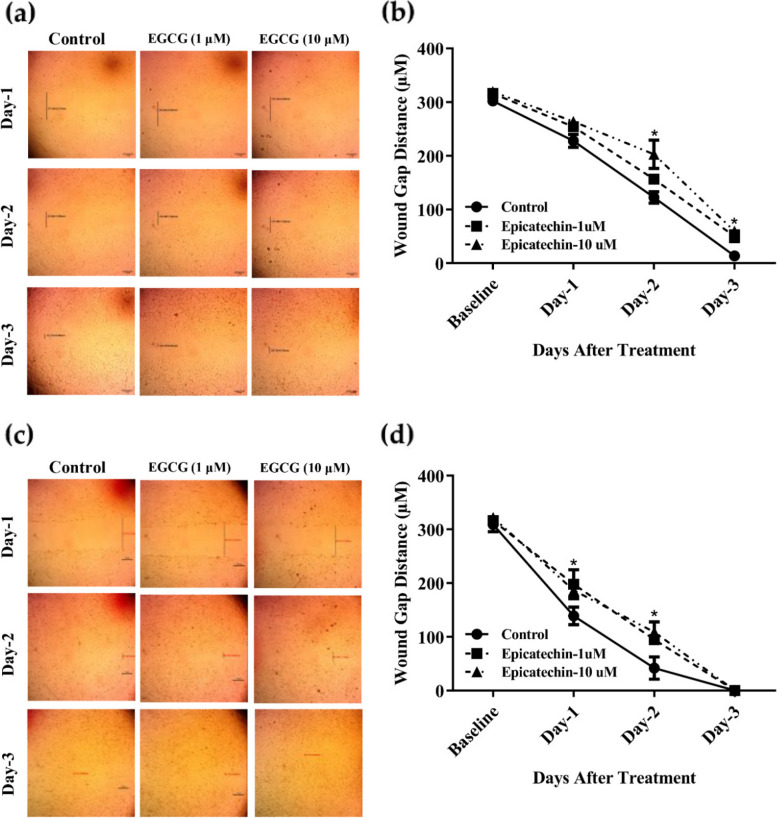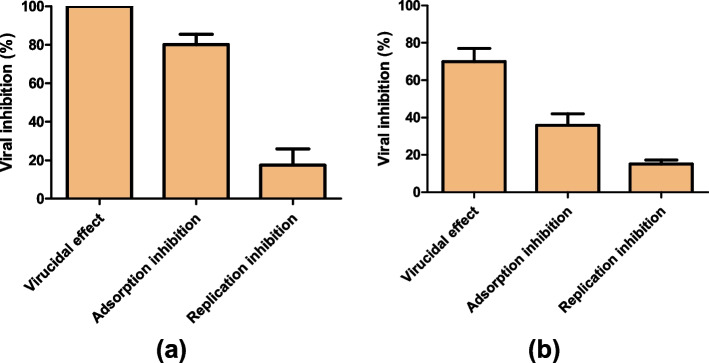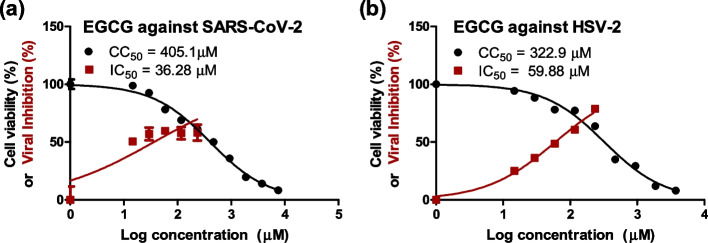表没食子儿茶素-3-没食子酸酯在病毒诱导细胞损伤中的双重作用。
IF 2.8
Q3 Biochemistry, Genetics and Molecular Biology
Journal of Genetic Engineering and Biotechnology
Pub Date : 2023-12-01
DOI:10.1186/s43141-023-00624-4
引用次数: 0
摘要
背景:病毒感染对受感染的人体组织造成损伤和长期损伤,需要抗病毒药物和伤口愈合药物治疗。因此,安全的植物化学分子可以控制病毒感染,并有能力为病毒引起的局部或全身组织损伤提供伤口愈合,这是有利的。在此,我们假设表没食子儿茶素-3-没食子酸酯(EGCG),绿茶中最丰富的多酚,可能作为伤口愈合,抗病毒和抗纤维化治疗有效。结果:观察了EGCG对严重急性呼吸综合征冠状病毒2型(SARS-CoV-2)和单纯疱疹病毒2型(HSV-2)的抗病毒活性以及对不同单层组织(连续和初代)系统的创面愈合活性。同时考虑到它可能的伤口愈合优势。为了确定EGCG在绿猴肾(Vero)和Vero- e6细胞系中的安全浓度,采用MTT法测定,CC50值分别为405.1 μM和322.9 μM。EGCG对SARS-CoV-2和HSV-2的抗病毒活性分别为36.28 μM和59.88 μM (IC50)。上述结果证实EGCG具有显著的病毒抑制活性,能够成功抑制SARS-CoV-2和HSV-2的体外复制,可接受选择性指数(SI)分别为11.16和5.39。同时,EGCG在人乳腺癌细胞(MCF-7)、其耐药变异(MCF-7adr)和人皮肤成纤维细胞(HSF)中显示出显著的剂量/时间依赖性抗迁移作用,表明它们在不同的内部和外用哺乳动物系统中具有愈合损伤的潜力。结论:EGCG已被证明是一种有效的抗病毒药物,同时也是一种具有伤口愈合作用的植物化学物质。我们认为EGCG可能是减缓由全身(2019冠状病毒病(COVID-19))或局部(HSV-2)病毒感染引起的急性细胞损伤过程的有希望的选择。本文章由计算机程序翻译,如有差异,请以英文原文为准。



Dual action of epigallocatechin-3-gallate in virus-induced cell Injury
Background
Viral infections cause damage and long-term injury to infected human tissues, demanding therapy with antiviral and wound healing medications. Consequently, safe phytochemical molecules that may control viral infections with an ability to provide wound healing to viral-induced tissue injuries, either topically or systemically, are advantageous. Herein, we hypothesized that epigallocatechin-3-gallate (EGCG), the most abundant polyphenol in green tea, might be effective as a wound healing, antiviral, and antifibrotic therapy.
Results
The antiviral activities of EGCG against severe acute respiratory syndrome coronavirus 2 (SARS-CoV-2) and Herpes simplex virus type 2 (HSV-2) as well as its wound healing activities against different monolayer tissue (continuous and primary) systems were investigated. Consider its possible wound-healing advantages as well. To determine the safe concentrations of EGCG in green monkey kidney (Vero) and Vero-E6 cell lines, MTT assay was performed and showed high CC50 values of 405.1 and 322.9 μM, respectively. The antiviral activities of EGCG against SARS-CoV-2 and HSV-2, measured as half-maximal concentration 50 (IC50) concentrations, were 36.28 and 59.88 μM, respectively. These results confirm that the EGCG has remarkable viral inhibitory activities and could successfully suppress the replication of SARS-CoV-2 and HSV-2 in vitro with acceptable selectivity indices (SI) of 11.16 and 5.39, respectively. In parallel, the EGCG exhibits significant and dose/time-dependent anti-migration effects in human breast cancer cells (MCF-7), its resistant variation (MCF-7adr), and human skin fibroblast (HSF) indicating their potential to heal injuries in different internal and topical mammalian systems.
Conclusions
The EGCG has proven to be an efficient antiviral against SARS-CoV-2 and HSV-2, as well as a wound-healing phytochemical. We assume that EGCG may be a promising option for slowing the course of acute cellular damage induced by systemic (Coronavirus Disease 2019 (COVID-19)) or topical (HSV-2) viral infections.
求助全文
通过发布文献求助,成功后即可免费获取论文全文。
去求助
来源期刊

Journal of Genetic Engineering and Biotechnology
Biochemistry, Genetics and Molecular Biology-Biotechnology
CiteScore
5.70
自引率
5.70%
发文量
159
审稿时长
16 weeks
期刊介绍:
Journal of genetic engineering and biotechnology is devoted to rapid publication of full-length research papers that leads to significant contribution in advancing knowledge in genetic engineering and biotechnology and provide novel perspectives in this research area. JGEB includes all major themes related to genetic engineering and recombinant DNA. The area of interest of JGEB includes but not restricted to: •Plant genetics •Animal genetics •Bacterial enzymes •Agricultural Biotechnology, •Biochemistry, •Biophysics, •Bioinformatics, •Environmental Biotechnology, •Industrial Biotechnology, •Microbial biotechnology, •Medical Biotechnology, •Bioenergy, Biosafety, •Biosecurity, •Bioethics, •GMOS, •Genomic, •Proteomic JGEB accepts
 求助内容:
求助内容: 应助结果提醒方式:
应助结果提醒方式:


